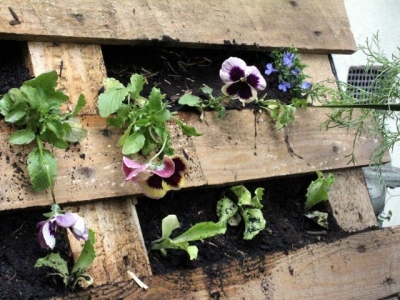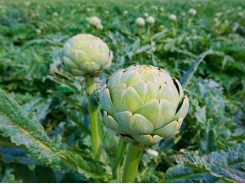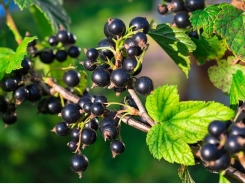How to Make a Pallet Garden

Photo: Various Brennemans, Flickr
In the US alone, approximately 2 billion pallets are used annually for shipping goods from factories to retail stores and other places of consumption (farmers receive everything from bags of fertilizer to rolls of irrigation tubing on pallets). The majority of which are not reused, and a staggering number are thrown into landfills each year.
Not surprisingly, an entire cottage industry has sprung up in recent years to re-purpose all those pallets, turning the wood into fences, decking material, shoe racks, and fine furniture. Making a wooden planter for veggies and herbs is one of the simplest pallet projects, requiring minimal carpentry skills and allowing you to create a stylish garden (in a rustic chic kind of way) suitable for small spaces.
Get Ready
Pallet planters are intended to be mounted vertically on a wall, so you can grow fresh food on a porch or balcony without sacrificing square footage in your outdoor space. Start by choosing a sunny wall capable of supporting 150 pounds or so (a pallet filled with soil and plants becomes quite heavy when wet) that you would like to transform into a lush, vertical garden. Then, seek out your pallet. A local nursery, construction company, grocery store, retail store, or a farmer friend are all likely candidates for finding a used pallet. Ask nicely and they are unlikely to turn you down after all, their pallets are likely destined for the landfill where they will have to pay in order to get rid of them.

Photo: Shutterstock
When picking out a pallet, look for one that’s in good condition, with no nails sticking out or pieces of cracked wood. Also, avoid pressure-treated pallets (those that have been treated with chemicals to prevent rot). It can be hard to tell if a pallet has been pressure-treated, but the wood is typically a darker, greyish color, and may have a slight green hue. Pallets made of light, tan-colored wood are a safer bet.
How to Make a Pocket-Style Planter
There are numerous ways to turn pallets into planters, but the following approach avoids the need for any sawing or additional wood, which simplifies the process. Instead, the design relies on landscape fabric (often called weed cloth), which can be purchased by the roll at any garden center. In addition, you will need a measuring tape, scissors, a staple gun, and two large bags of potting soil, plus the plants you wish to use.
The goal is to line the inside of the pallet with the cloth, creating big pockets to hold the soil. All pallets have a piece of wood that runs down the middle, so you will be creating two pockets one for either side of the wooden spine in the middle. Use the heaviest landscape fabric you can find; otherwise it will be vulnerable to tears and may not last as long.
- Measure the length and width of the pallet to determine the size of the pockets. Divide the width by two (since you’ll be lining each side of the pallet with a separate piece of fabric) and double the length (so the fabric is long enough to cover the front and back of the pallet). Add a few extra inches to each dimension so there’s a bit of extra fabric on all sides that can be stapled to the wood, and cut two pieces of fabric to this size.
- Stand the pallet up on one end so the central spine of the pallet is pointing up. Staple the narrow end of one of the pieces of fabric to the top edge of the wood on one side of the central spine. (If the pallet was laying flat on the ground this would be along the thin edge of the outer slat of wood.)
- Push the fabric into the inside of the pallet so that it lines up with the inside of the wooden slats on both sides of pallet. Make sure the fabric lays smooth against the slats without folds or ruffles and then staple the other end of the fabric to the top edge of the wooden slat opposite where the other edge was stapled. Cut off any excess length from the end of the fabric after stapling.
- Staple the edges of the fabric every 6 or 8 inches to the wood on the right and left sides inside the ‘pocket’, so soil cannot escape.
- Repeat the process for a second pocket on the other side of the central spine.
- Fill both pockets with potting soil, packing it down into the pallet with your hands so it doesn’t settle later.

Photo: Tutto Giardinaggio, Flickr
How to Mount and Plant
You can stand the planter on the ground against a wall (but screw it into or tie it onto a wall to prevent it from falling over). But if you want to mount it off the ground, you’ll need two large L-brackets to support it. Here’s how:
- Screw a pair of 4-inch galvanized L-brackets to the wall at the height where you want the bottom of the planter. Measure the space between the right and left edges of the pallet and install the brackets so they will line up with the 2x4s that form the sides of the pallet.
- With a helper, hoist the planter onto the horizontal surface of the brackets and screw the brackets to the 2x4s of the pallet from below.
- Cut slits in the fabric between the slats where you want to plant seedlings, following the spacing recommended for the crops you are planting. (The top of the pockets are ‘open’, so you can plant that part directly without making a cut.) Make the slits no larger than necessary to insert each seedling. Other than the top row of plants, all the seedlings will grow outwards from the face of the planter.
- Water thoroughly after planting through the openings at the top of the planter. The water will trickle down and eventually drain out the bottom through the porous fabric. Check the planter daily and water whenever the soil becomes dry the plants will likely need water every day when the weather is hot and sunny.
In many parts of the country, it’s not too late to plant seedlings of greens, herbs, and other cool weather edibles. And October is a fine time to plant perennial herbs in any region carpeting your pallet planter carpeted in thyme, oregano, and trailing rosemary, for example, makes an attractive and fragrant wall of foliage.
Related news
Tools

Phối trộn thức ăn chăn nuôi

Pha dung dịch thủy canh

Định mức cho tôm ăn

Phối trộn phân bón NPK

Xác định tỷ lệ tôm sống

Chuyển đổi đơn vị phân bón

Xác định công suất sục khí

Chuyển đổi đơn vị tôm

Tính diện tích nhà kính

Tính thể tích ao



 How to Grow Fruits, Vegetables, and Herbs in…
How to Grow Fruits, Vegetables, and Herbs in…  So Shady: 10 Crops That Can Be Grown…
So Shady: 10 Crops That Can Be Grown…